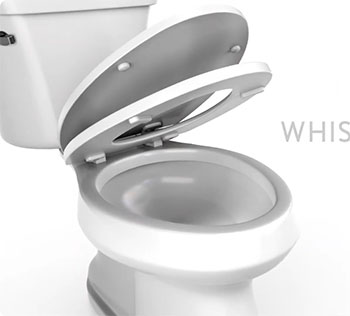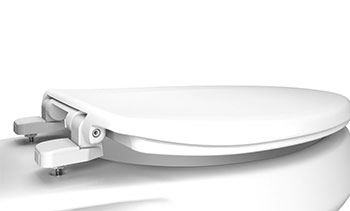Ah, the humble toilet seat – a seemingly simple yet surprisingly crucial component of our daily bathroom routines. Who would have thought that such an unassuming object could spark so much debate and contemplation? But alas, when it comes to choosing between an enameled wood toilet seat or a plastic one, the decision is far from trivial.
Whether you’re renovating your bathroom, replacing an old worn-out seat, or simply seeking a touch of luxury, the choice between these two materials can have a significant impact on both the aesthetic and functional aspects of your throne room experience.
Fear not, dear reader, for we shall delve deep into the pros and cons of each option, weighing their merits with a discerning eye and an analytical mindset. From durability and comfort to maintenance and style, we’ll leave no stone unturned in our quest to help you make an informed decision that suits your unique needs and preferences.
A Brief Comparison Table
So, let’s begin our exploration with a handy comparison table to whet your appetite:
| Feature | Enameled Wood Toilet Seat | Plastic Toilet Seat |
| Appearance | Classic, warm, and elegant | Contemporary, sleek, and minimalist |
| Durability | Highly durable if properly maintained | Durable but susceptible to cracks or discoloration over time |
| Comfort | Smooth and comfortable surface | Can feel cold or hard, depending on the material |
| Maintenance | Requires regular cleaning and occasional resealing | Generally easy to clean and maintain |
| Cost | More expensive than plastic | More affordable option |
Now, let’s dive deeper into the intricacies of these two toilet seat contenders, exploring their unique characteristics and shedding light on the factors that might sway your decision.
The Enameled Wood Allure
Enameled wood toilet seats exude a certain classic charm and elegance that can elevate the aesthetic appeal of any bathroom. This timeless material blends beauty and functionality, offering a warm and inviting touch to your sacred sanctuary.
- Aesthetic Appeal

One of the primary draws of enameled wood toilet seats is their undeniable visual appeal. The rich, natural grain of the wood, combined with the glossy enamel finish, creates a stunning and distinctive look that can complement a wide range of bathroom styles, from traditional to rustic to contemporary.
- Durability and Longevity
Despite their delicate appearance, enameled wood toilet seats are renowned for their durability and longevity. When properly cared for and maintained, these seats can withstand the test of time, resisting scratches, chips, and other forms of wear and tear that can plague their plastic counterparts.
- Comfort and Warmth
There’s something to be said about the comfort and warmth that enameled wood toilet seats provide. The smooth, non-porous surface offers a luxurious seating experience, while the natural insulating properties of wood ensure a pleasant temperature, even in the chilliest of bathroom environments.
- Customization and Style
Enameled wood toilet seats offer a level of customization and style that can be challenging to achieve with plastic alternatives. From vibrant colors to intricate designs and patterns, these seats can be tailored to suit your unique aesthetic preferences, allowing you to create a truly personalized and cohesive bathroom ambiance.
The Plastic Practicality
While enameled wood toilet seats may exude a certain charm and elegance, plastic toilet seats offer a different set of advantages that should not be overlooked. These practical and versatile options cater to those seeking a more low-maintenance and budget-friendly solution.
- Cost-Effectiveness

One of the most compelling advantages of plastic toilet seats is their affordability. Compared to their enameled wood counterparts, plastic seats are generally more cost-effective, making them an attractive option for those working with a tight budget or seeking a temporary solution.
- Easy Maintenance
Plastic toilet seats are widely praised for their ease of maintenance. Unlike enameled wood, which requires regular cleaning and occasional resealing, plastic seats can typically be wiped down with a simple household cleaner, making them a practical choice for busy households or those with limited time for extensive cleaning routines.
- Variety of Materials
Not all plastic toilet seats are created equal. From durable polypropylene to sleek acrylic, the plastic toilet seat market offers a diverse range of materials, each with its own unique properties and benefits. This variety allows you to choose a seat that aligns with your specific needs and preferences, whether you prioritize strength, flexibility, or a particular aesthetic.
- Hygiene and Cleanliness
Many plastic toilet seats are designed with hygiene and cleanliness in mind. Some models feature antimicrobial coatings or smooth, non-porous surfaces that resist the growth of bacteria, mold, and mildew, promoting a cleaner and healthier bathroom environment.
Factors to Consider
As with any significant purchase or home improvement decision, choosing between an enameled wood toilet seat and a plastic one requires careful consideration of various factors. Here are some key elements to keep in mind:
- Bathroom Style and Decor
The overall style and decor of your bathroom should play a significant role in your toilet seat selection. Enameled wood seats can complement traditional, rustic, or elegant bathroom designs, while plastic seats may be better suited for modern, minimalist, or contemporary aesthetics.
- Household Dynamics
Consider the dynamics of your household when making your choice. If you have young children or elderly family members, the warmth and comfort of an enameled wood seat may be preferable. Conversely, if you have a high-traffic bathroom or a busy household, the low-maintenance nature of plastic seats could be a more practical option.
- Durability and Lifespan
While both enameled wood and plastic toilet seats can offer durability, their respective lifespans may vary depending on usage and maintenance. Enameled wood seats, when properly cared for, can potentially outlast their plastic counterparts, making them a more long-term investment.
- Environmental Considerations
For those with a keen eye on sustainability, the environmental impact of each material should be taken into account. Enameled wood seats are generally considered more eco-friendly, as they are often made from renewable resources and can be recycled or repurposed at the end of their lifespan.
FAQs
The choice between enameled wood or plastic toilet seats ultimately depends on your personal preferences and priorities. Enameled wood seats offer a classic, elegant appearance and can be more durable if properly maintained, while plastic seats are generally more affordable, easier to clean, and may be better suited for high-traffic or humid environments.
There is no one-size-fits-all “best” material for toilet seats, as each option has its own advantages and drawbacks. Enameled wood seats are known for their beauty, warmth, and durability, while plastic seats are praised for their affordability, ease of maintenance, and hygiene-focused features. The ideal material will depend on your specific needs, budget, and personal preferences.
Cleaning an enameled wood toilet seat requires a gentle approach. Start by using a soft cloth or sponge dampened with a mild soap and water solution. Avoid abrasive cleaners or harsh chemicals, as they can damage the enamel finish. After cleaning, dry the seat thoroughly to prevent moisture buildup and potential warping or discoloration of the wood.
Wood toilet seats can stain for a variety of reasons, including exposure to moisture, cleaning products, or even certain bodily fluids. Over time, the porous nature of wood can allow these substances to seep in, causing discoloration or staining. Proper sealing and maintenance can help prevent staining, but some discoloration may still occur with prolonged use.
Also Read: KOHLER Rutledge Vs. Cachet Toilet Seats: In-depth Differences
Conclusion
As we bid farewell to our exploration of enameled wood and plastic toilet seats, it’s clear that both options hold their own unique charms and practical advantages. From the timeless elegance and warmth of enameled wood to the low-maintenance convenience and affordability of plastic, the choice ultimately rests upon your personal preferences, lifestyle, and priorities.
Remember, there is no one-size-fits-all solution when it comes to selecting the perfect toilet seat. Instead, it’s about finding the perfect balance between form and function, aesthetics and practicality, that aligns with your specific needs and creates a harmonious and inviting bathroom environment.
Whether you opt for the classic allure of enameled wood or the modern practicality of plastic, the key is to approach your decision with a discerning eye and an open mind. Consider the dynamics of your household, the style of your bathroom, and the level of maintenance you’re willing to commit to, and let those factors guide you towards the toilet seat that will truly elevate your throne room experience.
